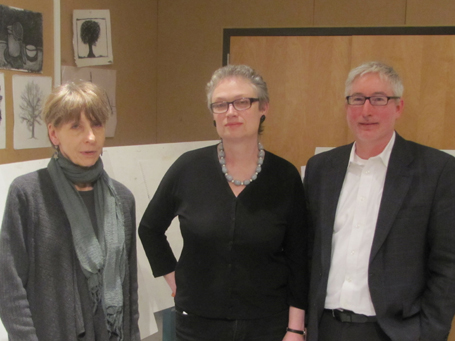Tuesday, Dec 7, 2010
Noted New York art critics Karen Wilkin and Lance Esplund visited Rider’s Art Studio for a candid talk about painting and the way we write about it.
by Sean Ramsden
A painting is seldom color on canvas, and nothing more. It is a way for artists to love and admire – to identify with – other artists, even from across the ages. As one painter might seek to experience the feelings of another through recognizable brush strokes, the works they yield almost seem to whisper knowingly to each other across time and space.
“Art is a dialogue with other art,” said Deborah Rosenthal, professor of Fine Arts, and a painter whose own work has been frequently exhibited at the Bowery Gallery in New York and hangs in the public collections of the Philadelphia Museum of Jewish Art and Bryn Mawr College, among others.
This dialogue is facilitated by critics such as Lance Esplund and Karen Wilkin, two of the more visible New York-based art reviewers in the United States, who recently visited Rosenthal’s classroom for a frank look at the paintings of Spanish surrealist Joan Miró (1893-1983), in an event called Two Critics: A Conversation.
Wilkin, an independent curator and critic specializing in 20th century modernism who also teaches in the Master of Fine Arts program at the New York Studio School, is a regular contributor to The New Criterion, Art in America and The Wall Street Journal, while Esplund, formerly of the New York Sun and now a critic for The Wall Street Journal, has written for Harper’s Magazine and The Weekly Standard as well.
Wilkin and Esplund’s discussed an exhibit currently showing at The Metropolitan Museum of Art in New York entitled Miró: The Dutch Interiors, which shows a series of three 1928 avant-garde paintings by Miró, juxtaposed with the works from the Dutch Golden Age that inspired them. The originals, 17th century genre paintings, impressed Miró’s during a visit to Amsterdam earlier in 1928, and inspired his more surreal interpretation. The critics showed slides of the Dutch interiors alongside Miró’s paintings for comparison.
On his trip, Miró bought postcards of paintings he liked, and later kept them on an easel as he worked. Though a cursory glance of his works shows little resemblance to the more realistic, everyday life scenes he admired, Miró earned acclaim by “extracting from the painting and creating new structures and analogies,” Esplund said. “His use of primary colors has an ingrained, metaphoric meaning.”
Rosenthal asked Esplund and Wilkin if their interpretations did not require them to “get into (Miró’s) skin a bit to understand the process.” Wilkin explained that the challenge is “to try to get rid of all your preconceptions and value judgments and just deal with what is going on here,” she said. “Then, you can decide how well the artist succeeds on his own terms.”
Students in the class then listened to Esplund explain how his artistic training allowed him to understand the merit behind this brand of copying in order to understand the work of a master.
“I trained as a painter, and my real grounding was as a student, drawing from other painters and from sculpture,” he said. “There was a connection I felt through this immersion, in trying to go through someone else’s motions and understand their process. I really wanted to feel and understand. Copying is a way to get inside the work and break down these barriers of judgment. It’s been vital to my experience of art.”
Wilkin agreed, though she believes that “you can, by looking very intently, have that ‘a-ha’ moment. It’s a different kind of experience, a feeling of getting it. It’s a very satisfying experience,” she said, adding that it is this “cumulative experience that changes the way you see things.”
When questioned by students, both critics recalled their beginnings in criticism, with Wilkin recalling her critical perusal of the old Montgomery Ward catalog as a child. “I used to go through it and say ‘yes,’ ‘no,’ ‘yes,’ ‘no,’” she wryly recalled. She continued to explain that she was working as a curator in Western Canada when a number of local artists asked her to trade on her connections in New York. She did, and was asked to write a 2,500 feature on the artists by a Manhattan editor.
“There was no looking back,” Wilkin said.
Esplund explained that he wanted to be both a painter and a writer, and “writing about art let me do both,” he said. “Writing about someone who may have lived hundreds or thousands of years ago helped connect me to them.”
Both agreed that in order to do their jobs correctly, they must be faithful to their response to art, rather than decide beforehand what their reactions will be.
“I try not to think about an audience at all,” Wilkin said. “All we’re doing is balancing our response and taste against what we’re confronted by.”
This approach, along with their experience, gives Wilkin and Esplund the credibility they need to maintain their careers. “The only reason anyone is interested in our opinions is because we’ve spent years and years looking at this stuff and thinking about it,” said Wilkin.
“And even then, it’s no guarantee!” Esplund added.
Following Two Critics: A Conversation, Rosenthal was pleased not only by the speakers, but her students’ response as well. “I thought it was a really wonderful talk, and the students’ intelligent questions demonstrated that,” she said.

